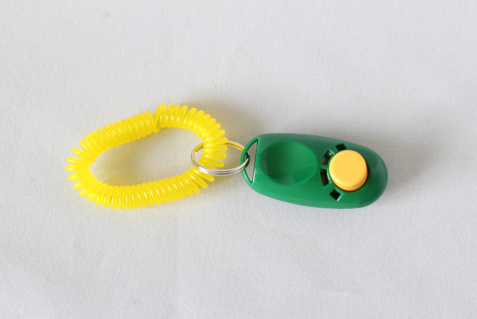
How do I use a clicker?
How Do I Use a Clicker?
You may have one (or several!) of these in a drawer somewhere, or perhaps tucked away in a treat pouch or forgotten in the pocket of your walking jacket; clickers are one of those things that are everywhere, and yet many people don't really understand what their purpose is or how to get the most out of them!
What Is a Clicker?

Clickers are generally mostly plastic, and will have a button or exposed section of the actual clicky-surface to allow you to press down and create the sound. This sound, the loud 'click!', is the whole point of this little object. You will often get little extra bits included with your clicker, such as wrist straps (as pictured above), but overall it's quite a simple thing. So, why all the mystery and confusion around how these things work?
What Are Clickers For?
Clickers are cheap to make, and as a result, have been given out as a 'freebie' alongside purchases of dog toys, training equipment, and even treats, for years now. By this point, many of us will have one, but sadly they never come complete with instructions, so the question remains - what is it actually for?!
Clickers are a training tool, and their purpose is to act as communication for our dogs. When we train with our dogs, we're teaching them to understand various cues and commands, and if you've worked with me or another trainer before, you should've heard about using a Marker word - simply put, a Marker word would be either 'Good!' or 'Yes!', and its purpose is to communicate to your dog what it is that they've done correctly so that they can repeat it. We then motivate them to repeat it by following up our Marker with a reward!
A clicker is just another method of Marking, so replaces the word 'Good' or 'Yes' with that 'click' sound. And that's it!
How Do I Use a Clicker in Training?
So, let's say for instance that you're working on teaching your dog to sit. What we're looking for is their bum to go down onto the floor when you give them the cue, and the second that happens we want to Mark it. If you were using a clicker, the second their bum hits the ground after you cue the sit, you would click to Mark it, and then follow this up with a reward.
Do Dogs Naturally Understand the Click Sound?
A common misconception I come across is that the sound a clicker makes is inherently rewarding to a dog, or that any dog will respond to it without prior exposure of training.
In reality, dogs don't come pre-programmed to respond to this click, and it's just another sound to them until we make it mean something.
The first time you heard the notification sound your phone makes, it won't have really meant much to you - it's just another noise. However, after a while, you've probably become quite well-programmed to reach for your phone or glance at the screen whenever that sound goes off, because that sound has come to equal messages, notifications, interactions. The dopamine hits we get from these notifications are what fuel us to keep checking every time we hear them come in.
The same thing goes for our dogs with the noise of a clicker - at first, it's just another sound, it holds no particular meaning. It might catch their attention being that it's quite a loud noise and novel in many respects, but they likely wouldn't respond to it after a few times hearing it.
However, if we follow each and every click with a tasty treat, or a game with their favourite toy, now that 'click!' sound comes to mean something really good, which is sure to grab our dog's attention. In fact, that's sure to get them working to try and hear more of those clicks, and in turn to get more of the rewarding stuff they now associate with this noise.
Should I Use a Clicker in Training?
This is really up to you - I always recommend that when getting started with training, whether it's with a puppy or an older dog, it's best to begin with a Marker word, such as 'Good' or 'Yes'. This is really because having one less thing to hold onto and physically focus on makes it much easier for you as the handler whilst working on exercises that will be new to you as well as your dog. Sometimes, that added step of remembering to click the clicker can overwhelm things, and delay your timing which is very important when training!
The benefit of using a clicker over a verbal Marker is that it's a very clear, precise sound, and as such can really help you to pinpoint very tiny little movements or moments in training, capture them, and build on them as you like. For this reason, a clicker is often a popular tool among those training in more advanced arenas, and for activities such as agility or other specialised disciplines.
Ultimately, you can use BOTH a clicker and a verbal Marker, but just not at the same time! Your dog can learn the sound for both, but you must always choose one or the other whenever you're training, using both would be unnecessary.
Hopefully this article has helped to de-mystify this bit of kit for you, and you now feel confident in how to use, or how not to use, a clicker in dog training!
For more training tips and tutorials, keep an eye on this blog, and if you're interested in getting hands-on, personalised help for you and your dog, book your free Discovery Call with me today to chat about what I can do for you.
